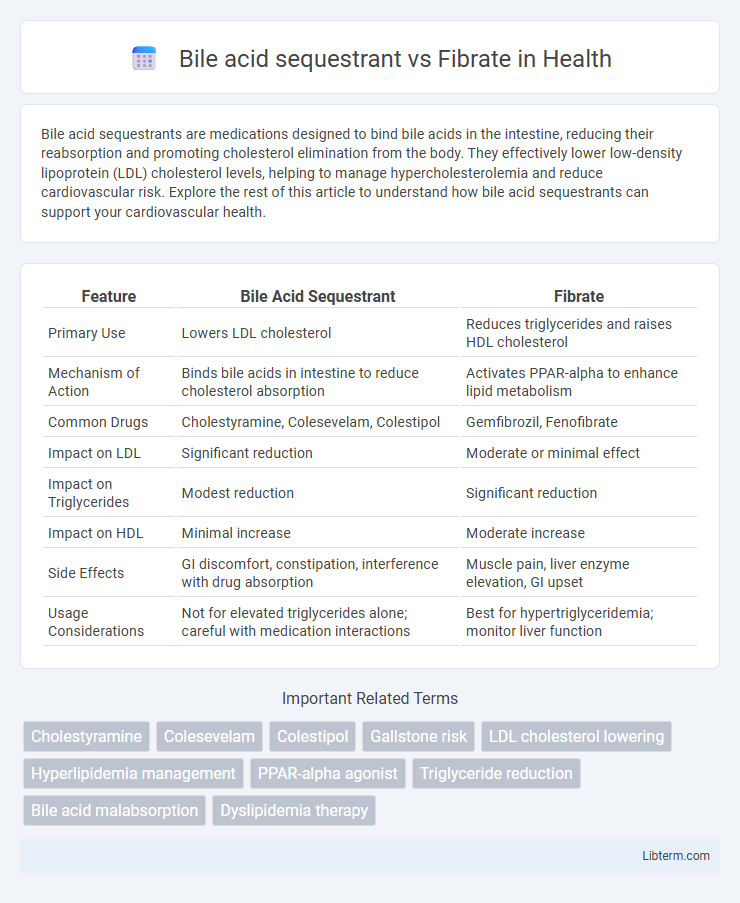Bile acid sequestrants are medications designed to bind bile acids in the intestine, reducing their reabsorption and promoting cholesterol elimination from the body. They effectively lower low-density lipoprotein (LDL) cholesterol levels, helping to manage hypercholesterolemia and reduce cardiovascular risk. Explore the rest of this article to understand how bile acid sequestrants can support your cardiovascular health.
Table of Comparison
| Feature | Bile Acid Sequestrant | Fibrate |
|---|---|---|
| Primary Use | Lowers LDL cholesterol | Reduces triglycerides and raises HDL cholesterol |
| Mechanism of Action | Binds bile acids in intestine to reduce cholesterol absorption | Activates PPAR-alpha to enhance lipid metabolism |
| Common Drugs | Cholestyramine, Colesevelam, Colestipol | Gemfibrozil, Fenofibrate |
| Impact on LDL | Significant reduction | Moderate or minimal effect |
| Impact on Triglycerides | Modest reduction | Significant reduction |
| Impact on HDL | Minimal increase | Moderate increase |
| Side Effects | GI discomfort, constipation, interference with drug absorption | Muscle pain, liver enzyme elevation, GI upset |
| Usage Considerations | Not for elevated triglycerides alone; careful with medication interactions | Best for hypertriglyceridemia; monitor liver function |
Introduction to Bile Acid Sequestrants and Fibrates
Bile acid sequestrants are lipid-lowering agents that bind bile acids in the intestine, preventing their reabsorption and promoting cholesterol conversion into bile acids, effectively reducing LDL cholesterol levels. Fibrates primarily target triglycerides by activating peroxisome proliferator-activated receptors (PPARs), which enhance lipoprotein lipase activity and increase the catabolism of very low-density lipoproteins (VLDL). Both classes serve distinct roles in dyslipidemia management, with bile acid sequestrants mainly lowering LDL cholesterol and fibrates focusing on triglyceride reduction.
Mechanism of Action: Bile Acid Sequestrants
Bile acid sequestrants lower LDL cholesterol by binding bile acids in the intestine, preventing their reabsorption and promoting their excretion. This interruption triggers the liver to convert more cholesterol into bile acids, thereby reducing circulating cholesterol levels. In contrast to fibrates, which activate peroxisome proliferator-activated receptors (PPARs) to reduce triglycerides, bile acid sequestrants primarily target cholesterol metabolism through enterohepatic circulation disruption.
Mechanism of Action: Fibrates
Fibrates primarily function by activating peroxisome proliferator-activated receptors (PPARs), particularly PPAR-alpha, which enhances the transcription of genes involved in lipid metabolism. This activation increases lipoprotein lipase activity, leading to accelerated catabolism of triglyceride-rich lipoproteins and reduced plasma triglyceride levels. Fibrates also increase high-density lipoprotein (HDL) cholesterol by stimulating the production of apolipoproteins AI and AII.
Clinical Indications and Uses
Bile acid sequestrants are primarily indicated for lowering LDL cholesterol levels in patients with hypercholesterolemia and are especially useful in preventing cardiovascular events. Fibrates are mainly used to reduce elevated triglycerides and increase HDL cholesterol in patients with hypertriglyceridemia and mixed dyslipidemia. Both drug classes serve complementary roles in lipid management, with bile acid sequestrants targeting cholesterol absorption and fibrates activating peroxisome proliferator-activated receptors (PPARs) to modulate lipid metabolism.
Lipid Profile Effects: Comparison
Bile acid sequestrants primarily lower LDL cholesterol by binding bile acids in the intestine, reducing cholesterol absorption and increasing hepatic LDL receptor activity, resulting in a 15-30% LDL reduction with minimal impact on triglycerides. Fibrates mainly target triglyceride levels, decreasing them by 20-50% through activation of peroxisome proliferator-activated receptors (PPAR-alpha), which enhances lipoprotein lipase activity and fatty acid oxidation, while moderately increasing HDL cholesterol by 10-20%. Compared to fibrates, bile acid sequestrants have limited effect on triglycerides and HDL, making fibrates more effective for hypertriglyceridemia, whereas bile acid sequestrants are primarily used for LDL cholesterol lowering.
Common Side Effects
Bile acid sequestrants commonly cause gastrointestinal side effects such as constipation, bloating, and abdominal discomfort. Fibrates primarily lead to muscle pain, weakness, and an increased risk of gallstones. Both drug classes may also cause elevated liver enzymes, necessitating regular monitoring during therapy.
Drug Interactions and Precautions
Bile acid sequestrants can reduce the absorption of several drugs including fat-soluble vitamins, warfarin, and levothyroxine, necessitating careful timing of administration to avoid decreased efficacy. Fibrates interact with statins, increasing the risk of myopathy and rhabdomyolysis, and can potentiate the effects of anticoagulants like warfarin, requiring close monitoring of coagulation parameters. Both drug classes require cautious use in patients with liver or kidney impairment and regular monitoring of lipid profiles and relevant biochemical parameters to prevent adverse effects.
Contraindications Overview
Bile acid sequestrants are contraindicated in patients with complete biliary obstruction and severe hypertriglyceridemia due to the risk of exacerbating triglyceride levels. Fibrates are contraindicated in individuals with severe liver impairment, gallbladder disease, and renal dysfunction because of the increased potential for hepatotoxicity and myopathy. Both drug classes require careful assessment of patient history to avoid adverse effects related to their specific contraindications.
Efficacy in Cardiovascular Risk Reduction
Bile acid sequestrants primarily lower LDL cholesterol by binding bile acids in the intestine, leading to modest reductions in cardiovascular risk, especially in patients intolerant to statins. Fibrates effectively reduce triglycerides and increase HDL cholesterol, showing greater benefit in patients with mixed dyslipidemia and elevated triglyceride-related cardiovascular risk. Clinical trials indicate fibrates may reduce cardiovascular events more significantly in specific subgroups, while bile acid sequestrants are favored for LDL cholesterol reduction and overall atherogenic risk management.
Choosing Between Bile Acid Sequestrants and Fibrates
Choosing between bile acid sequestrants and fibrates depends on the specific lipid abnormalities and patient profiles. Bile acid sequestrants primarily reduce LDL cholesterol by binding bile acids in the intestine, making them suitable for patients with elevated LDL levels and those who cannot tolerate statins. Fibrates effectively lower triglycerides and increase HDL cholesterol, making them the preferred option for patients with hypertriglyceridemia or mixed dyslipidemia.
Bile acid sequestrant Infographic

 libterm.com
libterm.com